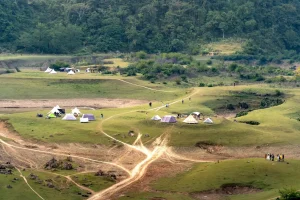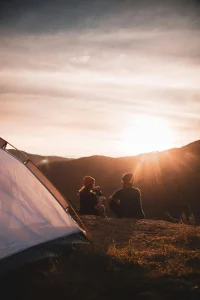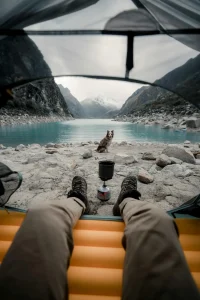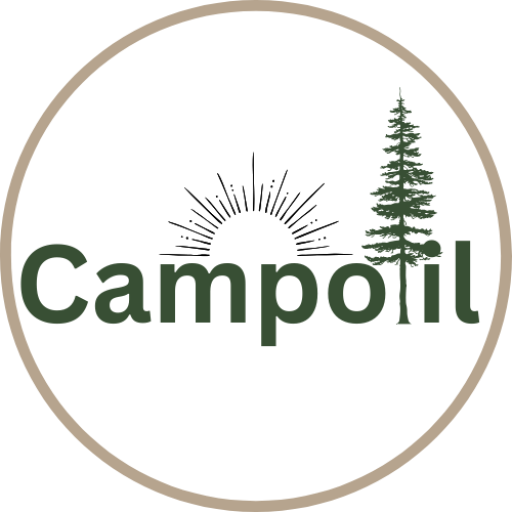Introduction: How to Choose the Best Campsite
Have you ever arrived at a campsite, only to find out it wasn’t quite the serene retreat you imagined? Maybe it was too close to a noisy road, or the terrain was uneven, making it difficult to set up your tent. I once had a camping trip where our site was near a group that stayed up late into the night, making it hard for us to get a good night’s rest. It was frustrating and took away from what could have been a peaceful experience. Choosing the right campsite is crucial for an enjoyable camping trip. It can make the difference between a rejuvenating adventure and an uncomfortable stay.
The best campsite is not one-size-fits-all; it depends on what you’re looking for. Whether you’re seeking a peaceful escape in the wilderness or a family-friendly spot with amenities, the right location can elevate your experience.
In this article, we’ll explore seven key factors to consider when selecting your campsite. From location and accessibility to noise levels and amenities, we’ll cover it all. Through real-world examples and personal insights, we’ll help you find the perfect spot for your next camping adventure. With the right choice, you can ensure that your trip is everything you’ve hoped for and more.
Here are some national parks examples:
These parks are excellent examples of national parks with campsites that offer unforgettable outdoor experiences. Whether you’re tent camping or RV camping, these destinations provide a mix of natural beauty and accessibility that makes them perfect for campers of all skill levels. However, keep in mind that these parks can get very busy, so reservations are often necessary, especially during peak seasons.
- Yellowstone National Park – America’s first national park, known for its geysers, hot springs, and wildlife. It has 12 campgrounds within the park, including Grant Village and Canyon Campground.
- Yosemite National Park – Famous for its granite cliffs, waterfalls, and giant sequoias. Campgrounds like Upper Pines and Half Dome Village (formerly Curry Village) are popular choices.
- Grand Canyon National Park – One of the most iconic natural wonders in the U.S. Campgrounds like Mather Campground on the South Rim and North Rim Campground are favorites among visitors.
- Great Smoky Mountains National Park – Renowned for its beautiful fall foliage and hiking trails. It offers 10 campgrounds, including Cades Cove and Smokemont.
- Zion National Park – Known for its stunning red rock formations and unique hiking trails like Angels Landing. Campgrounds like Watchman Campground are centrally located and offer easy access to the park’s main attractions.
Factor 1: Location and Accessibility

When planning your camping trip, one of the first things to consider is the location and accessibility of your campsite. A well-chosen location can make your adventure enjoyable and stress-free, while a poorly accessible site can turn your trip into a hassle. Let’s break this down into a few key points to help you make the best choice.
Proximity to Attractions
Imagine waking up every morning just a short walk from your favorite hiking trail or a serene lake. The closer your campsite is to these attractions, the more time you’ll have to enjoy them without the hassle of commuting. For instance, if you’re planning to explore the scenic trails of Yellowstone National Park, choose a campsite near the trailheads to maximize your hiking time. Similarly, staying near a lake in Acadia National Park could mean easy access to fishing and swimming spots.
Driving Distance and Road Conditions
The journey to your campsite is part of the adventure, but it shouldn’t be a stressful one. Consider how far the campsite is from your starting point and the condition of the roads leading to it. A campsite with well-maintained roads and a reasonable driving distance is ideal, especially if you’re traveling with family or have a lot of gear. For example, Grand Canyon National Park offers campsites that are easily accessible by car, making it a great option for those who prefer a smooth ride. On the other hand, more remote locations might require a 4×4 vehicle and can add time and effort to your trip.
Accessibility for Different Vehicle Types
Not all campsites are created equal when it comes to vehicle access. If you’re driving an RV or a larger vehicle, it’s crucial to ensure the campsite can accommodate it. Some campsites have size restrictions or tight spaces that can make maneuvering difficult. For instance, Yosemite National Park has RV-friendly sites, but it’s essential to check their size limits before booking. If you’re tent camping with a regular car, this might not be as much of a concern, but it’s still good to be aware of the site’s accessibility.
Availability of Parking
Finally, parking availability is a practical consideration that’s often overlooked. Imagine arriving at your campsite after a long drive, only to find limited parking spots. Look for campsites that offer ample parking for your vehicle type. Rocky Mountain National Park is a great example of a site with well-organized parking areas, ensuring a smooth check-in process.
Expert Tip: Always check the campsite’s website or contact the park ranger before your trip to confirm road conditions, vehicle accessibility, and parking availability. Spending a few minutes researching can save you hours of potential frustration.
Factor 2: Terrain and Ground Conditions
When you’re planning a camping trip, it’s important to think about the terrain and ground conditions of your campsite. The ground where you pitch your tent can make a big difference in how comfortable and safe your stay is.
First, consider whether the ground is flat or sloped. A flat area is usually best because it makes it easier to set up your tent and ensures you sleep comfortably. Imagine trying to sleep on a slope—it’s like sleeping on a slide! Parks like Yosemite National Park often have well-maintained, flat areas that are perfect for camping.
Next, think about the type of ground—whether it’s dirt, gravel, or grass. Grass is often the most comfortable, but it can get muddy if it rains. Dirt and gravel can be firmer and might require stronger tent stakes to secure your tent.
Another thing to consider is drainage. If it rains, water needs to drain away from your tent. If the ground doesn’t drain well, you could end up in a messy puddle. Great Smoky Mountains National Park is a place where rain is common, so choosing a spot with good drainage there is crucial.
Also, watch out for rocks and roots. Clearing them before setting up your tent will make your stay more comfortable and prevent any damage to your gear. A smooth, clear spot will make your camping experience much better.
Expert Advice: Always look for a flat area and clear any rocks or roots before pitching your tent. If you’re in an area that might flood, set up your tent on higher ground. A little preparation goes a long way in ensuring a great camping adventure!

Factor 3: Shade and Sunlight
When choosing the perfect campsite, considering the balance between shade and sunlight is essential for a comfortable camping experience. Here’s how to approach this important factor:
Importance of Shade During Hot Weather
Shade is a blessing, especially on hot summer days. Imagine setting up your tent in the scorching sun without any shade—it can quickly become unbearable. Look for campsites with trees or natural canopies to provide relief from the heat. For example, Zion National Park offers campsites with tree coverage, making your stay more pleasant even during peak summer.
Desirability of Sunlight for Solar Power or Drying Gear
If you plan to use solar panels to charge your devices, sunlight is crucial. Acadia National Park has open areas where sunlight is plentiful, perfect for harnessing solar energy. Additionally, sunlight helps in drying wet clothes or gear after a rainy day, so a balance between shade and sun is ideal.
Orientation of the Campsite in Relation to the Sun
The direction your campsite faces matters. An east-facing site offers lovely morning sun, while a west-facing one might be too hot in the evening. Consider the time of day you prefer to relax and plan accordingly.
Availability of Natural or Artificial Shade
Natural shade from trees is the best, but if it’s scarce, you might need artificial options like a canopy or tarp. Even with natural shade, it’s wise to have a backup plan for unexpected sunny days.
Expert Advice: Check the campsite’s layout for shade and sunlight, and tailor your choice to the season. In summer, prioritize shade for cooling, while in cooler seasons, a sunnier spot may be preferable for warmth. Always have a backup plan for artificial shade if needed. A well-chosen campsite ensures you stay comfortable and enjoy your surroundings.
Factor 4: Privacy and Spacing
When choosing the best campsite, privacy and spacing are key to a peaceful experience. Here are four things to consider:
- Distance Between Campsites: Look for campsites that are far apart. Yellowstone National Park has spacious sites, making it easy to enjoy nature without being too close to others.
- Natural Barriers: Places with trees and bushes provide natural privacy. For example, the lush areas in Great Smoky Mountains National Park help keep your campsite secluded.
- Proximity to Common Areas: It’s nice to be near restrooms or a playground for kids. Grand Canyon National Park offers campsites close to these areas but still quiet.
- Noise Levels: Busy spots can be noisy. Opt for quieter campsites away from playgrounds. Try this at Acadia National Park for a peaceful stay.
Expert Tip: Arrive early to claim a spot away from crowds. Check the campsite map to select a spot that fits your needs for privacy and convenience.
Factor 5: Amenities and Facilities
When choosing the best campsite, it’s essential to consider the amenities and facilities available. Campgrounds differ in what they offer, and the right amenities can make your trip more convenient and enjoyable. Here’s a breakdown of the key amenities to look for:
- Restrooms and Showers
Clean restrooms and showers are must-haves for many campers. If you’re not into primitive camping, look for campsites with flush toilets and showers. For example, Yellowstone National Park offers campsites with modern restrooms. - Access to Potable Water
Having a reliable source of drinking water is crucial. Check if the campsite provides water pumps or spigots. Zion National Park is a great example of a park with accessible water sources. - Fire Pits or Grills
Fire pits are perfect for cooking meals or enjoying a campfire. Many campsites, like those in Grand Canyon National Park, include fire rings or grills, especially in areas where campfires are allowed. - Electrical Hookups
If you’re bringing electronics or an RV, electrical hookups are a must. Yosemite National Park has sites with hookups for RVs and basic power needs. - Wi-Fi
While camping is about disconnecting, having Wi-Fi can be handy for planning. Some parks, like Acadia National Park, offer Wi-Fi at select spots. - Dump Stations for RVs
For RV campers, dump stations are essential for waste disposal. Parks like Joshua Tree National Park or Great Smoky Mountains National Park have these facilities.
Expert Tip: Choose a campsite based on the amenities you need. For example, if you want to disconnect, opt for a primitive site. If you need modern comforts, select a site with full hookups. Plan ahead by checking the campsite’s website or contacting the park ranger. Enjoy the convenience of having what you need for an easy and fun trip!

Factor 6: Safety and Security
When selecting a campsite, safety and security are paramount to ensure a worry-free camping experience. Here are four key considerations to keep in mind:
- Wildlife Presence and Safety Precautions
Wildlife encounters can be a thrilling part of camping, but they also require caution. In places like Yellowstone National Park, bears and other wildlife are present, so it’s crucial to store food and trash properly. Use bear-resistant containers if necessary. - Potential for Severe Weather
Certain areas are prone to severe weather conditions. For example, the Grand Canyon National Park experiences flash floods during heavy rains. Always check the weather forecast and be aware of your surroundings. - Security of Belongings
Protecting your gear is essential. Opt for campsites with secure areas or lockers. Keep valuables safe and out of sight to prevent theft. - Emergency Contact Information
Knowing who to contact in case of an emergency is vital. Ensure you have the park ranger’s contact information and know the nearest emergency services.
Expert Advice: Always research the campsite’s safety guidelines and be prepared for emergencies. Check weather forecasts, secure your food, and keep emergency contacts handy. Stay informed and cautious to enjoy a safe camping trip.
Factor 7: Personal Preferences and Activities
When planning your camping trip, your personal preferences and the activities you wish to pursue play a significant role in choosing the ideal campsite. These factors ensure that your camping experience aligns with your lifestyle and recreational goals.
A. Type of Camping
The type of camping you prefer—whether it’s tent camping, RV camping, or car camping—guides your campsite selection. Tent campers often require a flat, grassy area, while RV campers need sites with electric hookups and ample space for maneuvering. For instance, Yosemite National Park offers campsites that cater to both tent and RV campers, providing the necessary amenities for each.
B. Desired Activities
Your choice of activities will influence the location of your campsite. If hiking is your passion, proximity to trails is essential. Yosemite, known for its extensive hiking trails, is an excellent choice. If fishing or swimming is on your agenda, consider a campsite near a lake or river, such as those found in Acadia National Park.
C. Group Size and Needs
The size of your group and their specific needs are crucial. Larger groups require more space, often found in open areas that can accommodate everyone comfortably. Families with children may prefer campsites with access to playgrounds and restrooms, which parks like Acadia readily provide.
D. Level of Solitude or Social Interaction
Some campers seek tranquility and solitude, while others enjoy a more social atmosphere. For those desiring peace, a secluded spot in Olympic National Park offers the perfect retreat. Conversely, campsites near busy areas, like those in the Grand Canyon, cater to those who prefer social interaction.
Conclusion
When selecting the perfect campsite, it is essential to consider seven key factors: location, terrain, shade, amenities, safety, personal preferences, and activities. Each of these elements plays a crucial role in shaping your camping experience.
- Location and Accessibility: Ensures your campsite is convenient and reachable.
- Terrain and Ground Conditions: Affects comfort and safety.
- Shade and Sunlight: Balances comfort and functionality.
- Privacy and Spacing: Ensures a peaceful environment.
- Amenities and Facilities: Provides necessary comforts.
- Safety and Security: Guards against potential risks.
- Personal Preferences and Activities: Tailors the experience to your needs and interests.
Planning and research are vital to ensure your campsite meets your requirements, enhancing your overall experience. Consider your group size, desired activities, and the level of solitude or social interaction you prefer. Prioritize what matters most to you, whether it’s the convenience of amenities or the tranquility of a secluded spot.
In the end, the effort you put into choosing the right campsite is worthwhile. The satisfaction of finding a spot that aligns with your vision creates lasting memories and ensures a fulfilling camping experience.
10 FAQs About Choosing the Best Campsite
- How do I choose the best campsite for my needs?
Consider factors like location, accessibility, terrain, shade, amenities, safety, and personal preferences. Research the campsite beforehand and check reviews to ensure it aligns with your plans and comfort level. - What are the key factors to consider when selecting a campsite?
Key factors include proximity to attractions, ground conditions, availability of shade and sunlight, privacy, amenities like restrooms and water, safety measures, and your planned activities. Each factor contributes to a comfortable and enjoyable camping experience. - How can I ensure access to clean drinking water?
Look for campsites with potable water sources, such as water pumps or spigots. Carry a water filter or purification tablets as a backup, especially if you’re unsure of the water quality. - How do I find a campsite with adequate privacy?
Opt for campsites with natural barriers like trees or bushes. Check the campsite map for secluded spots and consider visiting during off-peak times to enhance your privacy. - What precautions should I take to avoid wildlife encounters?
Store food and trash properly, using bear-resistant containers if necessary. Avoid leaving food or scented items out in the open and be aware of your surroundings, especially in areas known for wildlife. - How do I choose a campsite based on my planned activities?
If you plan to hike, look for sites near trails. For fishing or swimming, choose campsites near bodies of water. Ensure the campsite supports your activities and provides necessary facilities. - What should I look for in a campsite if I’m traveling with children?
Consider campsites with family-friendly amenities like playgrounds, restrooms, and access to water. Proximity to attractions can also keep children entertained and engaged. - How do I secure a spot if I arrive late?
Many campsites offer first-come, first-served spots, but it’s wise to book in advance, especially during peak seasons. Arrive early if possible, and have a backup plan if your preferred spot is taken. - What are my options if the campsite is fully booked?
Look for alternative campsites nearby, consider dispersed camping if allowed, or try visiting during less busy times. Flexibility can help you find a suitable spot even without a reservation. - How can I find affordable campsites that offer good value for money?
Compare prices and amenities among campsites. Consider visiting during off-peak seasons or opting for basic sites to save money. National parks often offer affordable options with great access to natural attractions.
